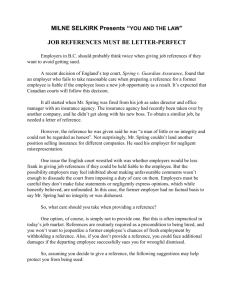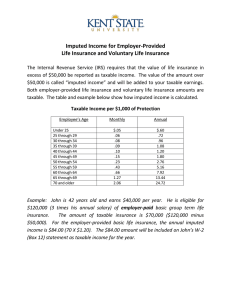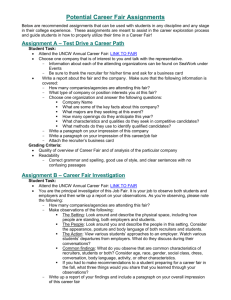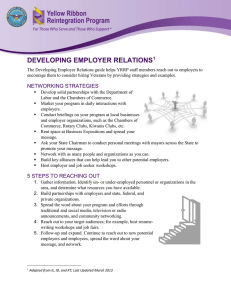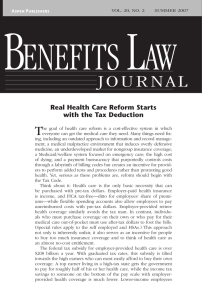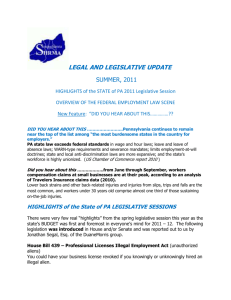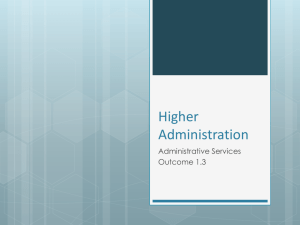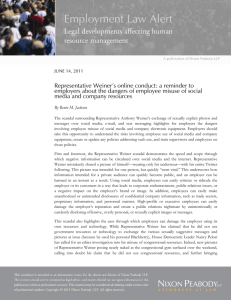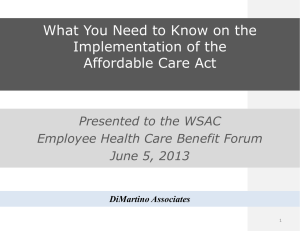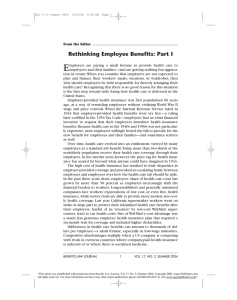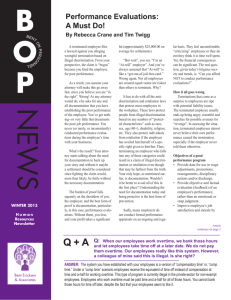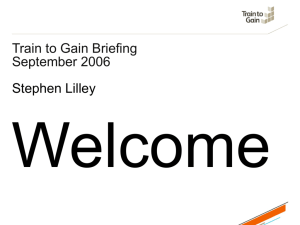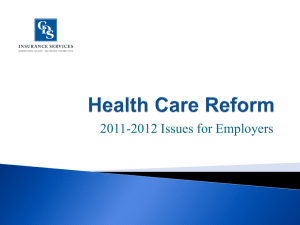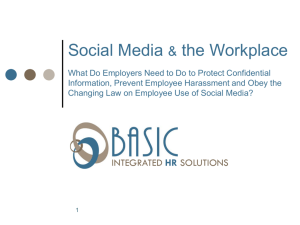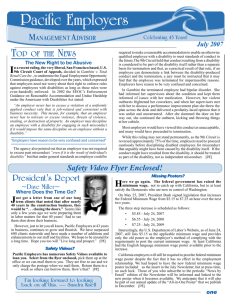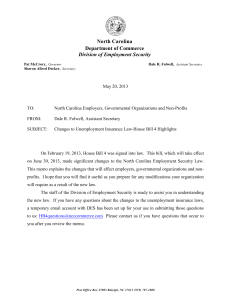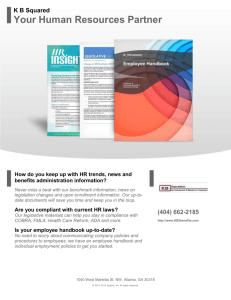Section 127 Employer-Provided Educational Assistance Benefits
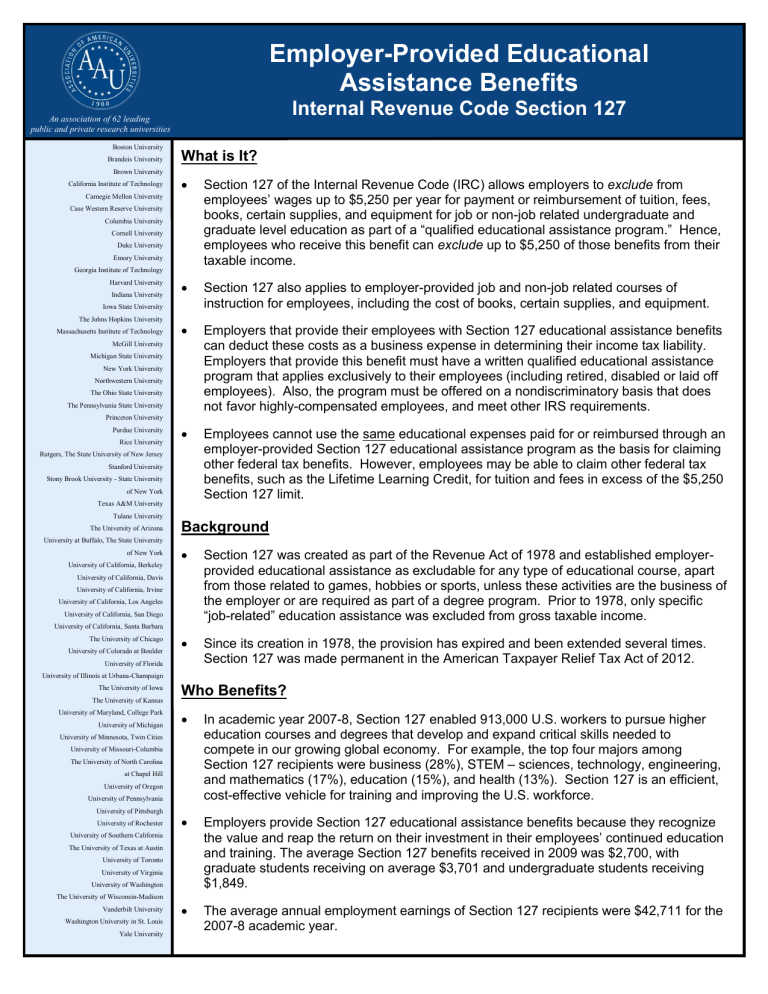
Employer-Provided Educational
Assistance Benefits
Internal Revenue Code Section 127
An association of 62 leading
public and private research universities
Boston University
Brandeis University
Brown University
California Institute of Technology
Carnegie Mellon University
Case Western Reserve University
Columbia University
Cornell University
Duke University
Emory University
Georgia Institute of Technology
Harvard University
Indiana University
Iowa State University
The Johns Hopkins University
Massachusetts Institute of Technology
McGill University
Michigan State University
New York University
Northwestern University
The Ohio State University
The Pennsylvania State University
Princeton University
Purdue University
Rice University
Rutgers, The State University of New Jersey
Stanford University
Stony Brook University - State University of New York
Texas A&M University
Tulane University
The University of Arizona
University at Buffalo, The State University
of New York
University of California, Berkeley
University of California, Davis
University of California, Irvine
University of California, Los Angeles
University of California, San Diego
University of California, Santa Barbara
The University of Chicago
University of Colorado at Boulder
University of Florida
University of Illinois at Urbana-Champaign
The University of Iowa
The University of Kansas
University of Maryland, College Park
University of Michigan
University of Minnesota, Twin Cities
University of Missouri-Columbia
The University of North Carolina at Chapel Hill
University of Oregon
University of Pennsylvania
University of Pittsburgh
University of Rochester
University of Southern California
The University of Texas at Austin
University of Toronto
University of Virginia
University of Washington
The University of Wisconsin-Madison
Vanderbilt University
Washington University in St. Louis
Yale University
What is It?
Section 127 of the Internal Revenue Code (IRC) allows employers to exclude from employees’ wages up to $5,250 per year for payment or reimbursement of tuition, fees, books, certain supplies, and equipment for job or non-job related undergraduate and graduate level education as part of a “qualified educational assistance program.” Hence, employees who receive this benefit can exclude up to $5,250 of those benefits from their taxable income.
Section 127 also applies to employer-provided job and non-job related courses of instruction for employees, including the cost of books, certain supplies, and equipment.
Employers that provide their employees with Section 127 educational assistance benefits can deduct these costs as a business expense in determining their income tax liability.
Employers that provide this benefit must have a written qualified educational assistance program that applies exclusively to their employees (including retired, disabled or laid off employees). Also, the program must be offered on a nondiscriminatory basis that does not favor highly-compensated employees, and meet other IRS requirements.
Employees cannot use the same educational expenses paid for or reimbursed through an employer-provided Section 127 educational assistance program as the basis for claiming other federal tax benefits. However, employees may be able to claim other federal tax benefits, such as the Lifetime Learning Credit, for tuition and fees in excess of the $5,250
Section 127 limit.
Background
Section 127 was created as part of the Revenue Act of 1978 and established employerprovided educational assistance as excludable for any type of educational course, apart from those related to games, hobbies or sports, unless these activities are the business of the employer or are required as part of a degree program. Prior to 1978, only specific
“job-related” education assistance was excluded from gross taxable income.
Since its creation in 1978, the provision has expired and been extended several times.
Section 127 was made permanent in the American Taxpayer Relief Tax Act of 2012.
Who Benefits?
In academic year 2007-8, Section 127 enabled 913,000 U.S. workers to pursue higher education courses and degrees that develop and expand critical skills needed to compete in our growing global economy. For example, the top four majors among
Section 127 recipients were business (28%), STEM – sciences, technology, engineering, and mathematics (17%), education (15%), and health (13%). Section 127 is an efficient, cost-effective vehicle for training and improving the U.S. workforce.
Employers provide Section 127 educational assistance benefits because they recognize the value and re ap the return on their investment in their employees’ continued education and training. The average Section 127 benefits received in 2009 was $2,700, with graduate students receiving on average $3,701 and undergraduate students receiving
$1,849.
The average annual employment earnings of Section 127 recipients were $42,711 for the
2007-8 academic year.
Additional information
Coalition to Preserve Employer Provided Education Assistance website: http://www.cpepea.com/
“Who Benefits from Section 127? – A Study of Employee Education Assistance Provided Under Section 127 of the Internal Revenue Code,” 2010, http://www.cpepea.com/research-surveys .
Joint Committee on Taxation Report, JCX-62-12, "Present Law and Background Relating to Tax Exemptions and Incentives for Higher Education" – https://www.jct.gov/publications.html?func=startdown&id=4474 .
Congressional Research Service Report, “Tax Treatment of Employer Educational Assistance for the Benefit of
Employees,” Order Code RS22911, July 3, 2008.
– March 2014




